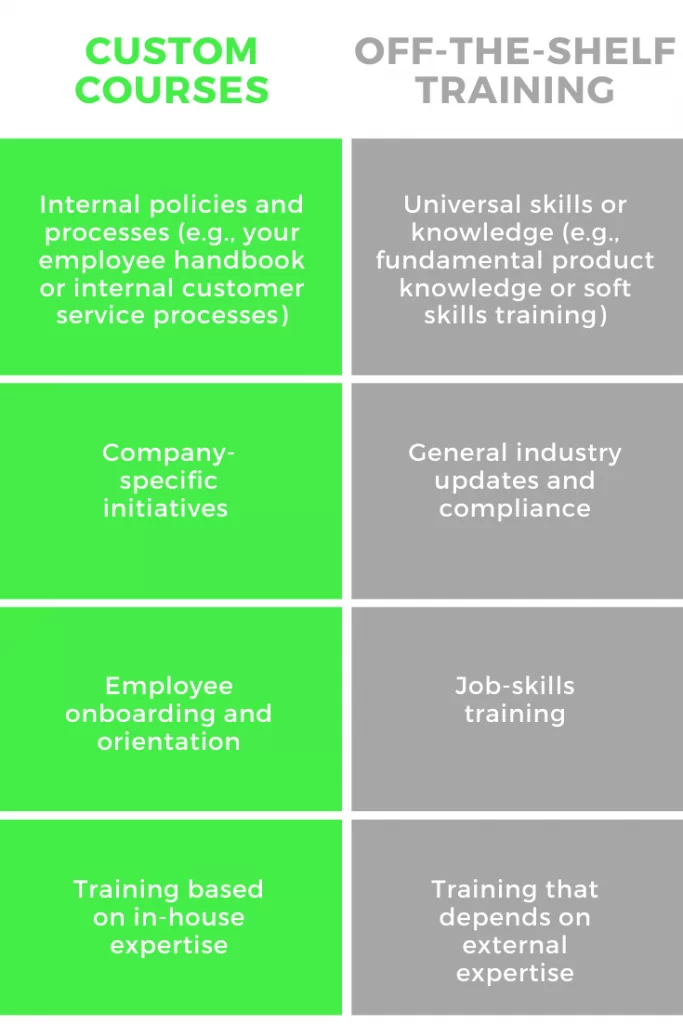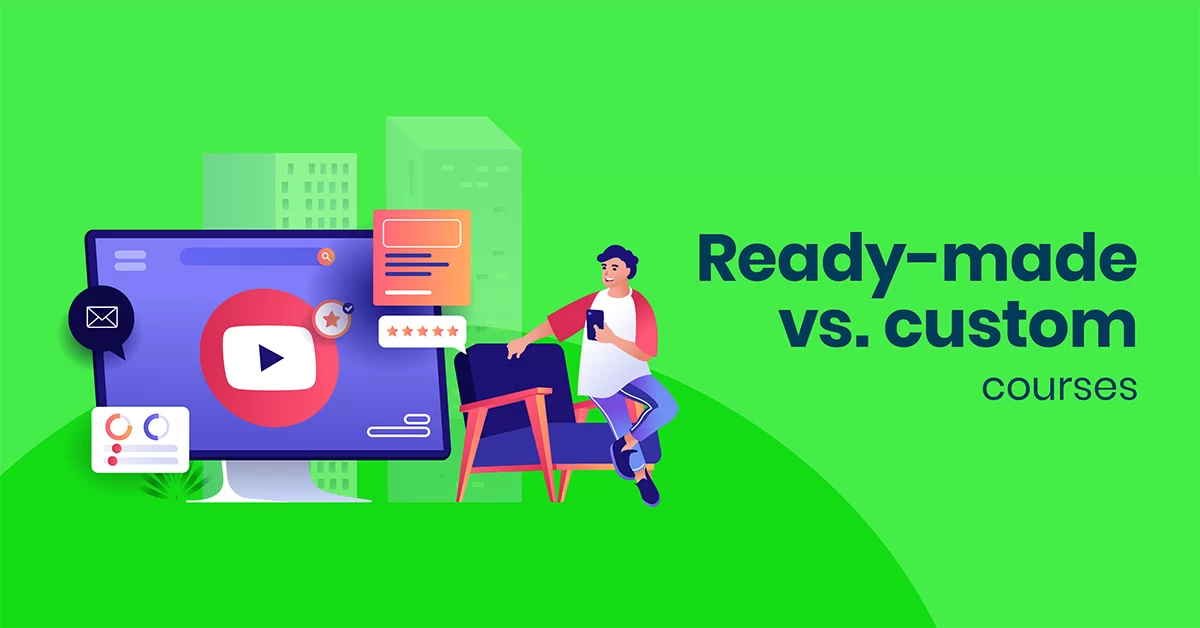Off-the-shelf training is ready-made content you can plug directly into your existing development program. Unlike custom content, which you create yourself, either with an internal team or with an outside vendor, pre-built courses are ready to use right out of the box.
There are pros and cons to each type of content. So, which is best? Does a successful training strategy require completely customizing courses for your organization?
The truth is, whether you’re a small business with no training department or a large organization with lots of dedicated resources, off-the-shelf training courses can be a big boost to your training efforts. It all comes down to knowing when to use them and how to leverage them in your organization.
6 benefits of ready-made online courses
Off-the-shelf training offers many advantages. Consider the following six reasons it may be a great option for your employee training program:
1. Lower costs
Cost savings is one of the most obvious benefits of pre-developed training. Building custom employee training courses takes time and expertise. That means hiring subject matter experts and instructional and graphic designers, or budgeting for outside vendors to do the job. You should also consider the costs of adding dynamic and engaging elements to the content.
For example, say you need to train your salespeople on conflict management and you want to create a course that will keep learners’ attention. You decide the best way to showcase the skills you want your people to develop is to include video scenarios. If you’re building the training course, that means added expenses of video equipment and editing software, plus the staff who know how to edit those videos.
Good off-the-shelf training courses take instructional design and engagement into account. With all the components already in place, you save time and resources.
2. Faster time to training
Once you know what skills and knowledge your employees need, you want to get them learning quickly so you can start seeing the benefits. Off-the-shelf training means no time lost to development and implementation.
As soon as you pin down your strategy and decide on the content you want, you can purchase courses and get things rolling. Training is ready to deploy and doesn’t require testing or revision. And the sooner people start learning, the more quickly they’ll apply their new skills on the job.
3. Access to broader expertise
Training should help your employees keep up with the skills and best practices they need to be successful. You won’t always have specialists on every topic in-house, so you’ll need to turn elsewhere. Pre-built training is generally created by instructors and experts with extensive knowledge of the subject matter, so you can access a wider range of expertise by purchasing ready-made online courses.
For example, say you want to improve your IT employees’ soft skills. You know the ability to work well with others improves employee satisfaction and increases productivity. But that’s not exactly your company’s wheelhouse. With ready-made communications training, you can reap the benefits of proven knowledge.
4. Built-in support and upgrades
When you buy training from an outside vendor, the supplier is responsible for providing support and, in some cases, even upgrading the content. That means you can be sure your training is current with the latest changes in compliance requirements, technical skills, and industry trends.
And when you don’t have to worry about scrambling to solve technical glitches, you can focus on rolling out the most effective training plans.
5. A library of general knowledge topics
Sometimes you need to create custom training that focuses on company-specific content. But when it comes to more general knowledge, there’s no need to reinvent the wheel. Off-the-shelf options can be ideal when your employees need straightforward education on things like common office software or basic industry compliance standards.
That leaves you with plenty of resources to allocate to topics that are relevant to your company. Besides, courses on general knowledge are a great option for self-learning. In other words, employees can choose topics that interest them and take courses at their own pace, since they won’t be tied to their day-to-day tasks.
6. Access to a wider variety of content types
Companies that specialize in training development have more research and design resources than you’re likely to in-house. You get high-quality digital assets and a greater diversity of mediums—for example, videos and animations that illustrate key points. And increased variety means your training is more accessible to different types of learners.

Is off-the-shelf training always the best option?
While there are many benefits to using ready-made content, there are times when a more tailored approach may be a better fit. Knowing how and when to use each will ensure the best employee development experience.
For example, you might prefer custom development when you want to:
- Train your teams on company-specific topics or promote your brand
- Train employees on internal policies or procedures
- Kick off a new company-wide initiative
- Onboard new employees
You may also want to invest in building custom training when you have internal expertise on a specific training topic. For example, if your organization has built a custom product for tracking orders and responding to customers, you’ll want the internal developers involved in creating training around it.
The following table can help you weigh custom vs. off-the-shelf training and decide when to use each:

Making the most out of ready-made courses
When it does make sense to use off-the-shelf training, know how to leverage it to best serve your employees. Here are a few tips for getting the most out of pre-built courses.
Choose the right LMS
The whole point of ready-made online courses is effective learning and easy implementation. To take advantage of that, make sure you choose an LMS that’s compatible with the courses you want to purchase. Then it’s just a matter of plugging them in and you’re off and running.
Customize where you can
You can often make ready-made online courses feel custom by tailoring them to match your brand. While the content is out of your hands, many providers still give you the option to personalize the look and feel.
For instance, if you can upload those courses to your LMS, you can make them part of a larger training series. Employees will log in to the same platform, see the same interface, and enjoy the ready-made content the same way they take your custom courses.
Combine ready-made with custom courses
Off-the-shelf courses and custom-made content are not mutually exclusive. On the contrary, you can get value by combining the strengths of each.
For example, say you want to train your teams on workplace safety. You can purchase a pre-made course with some general guidelines that all employees should be aware of. Then, you can create a training course with company-specific policies or more in-depth instructions for different jobs.
To make this work with ready-made online courses, make sure you choose an LMS that lets you both use off-the-shelf courses and add your own training content.
By using both kinds of content, you’ll be able to focus your development efforts on content that is unique to your organization and still meet your training objectives.
Put off-the-shelf training to work for your employees
A custom training strategy doesn’t always mean custom training courses. It means you offer training on specific skills that will help your employees succeed and your company grow. And ready-made courses are a quick and efficient way to do so.
Whether you decide to design your training completely in-house or choose to invest in off-the-shelf courses, focus on quality. Providing quality learning lets your employees know you’re investing in them and their futures. They’ll be more equipped to do their jobs and happier to stay with you for the long haul.



